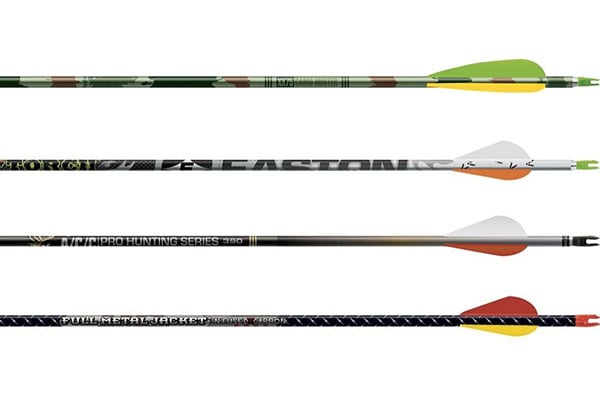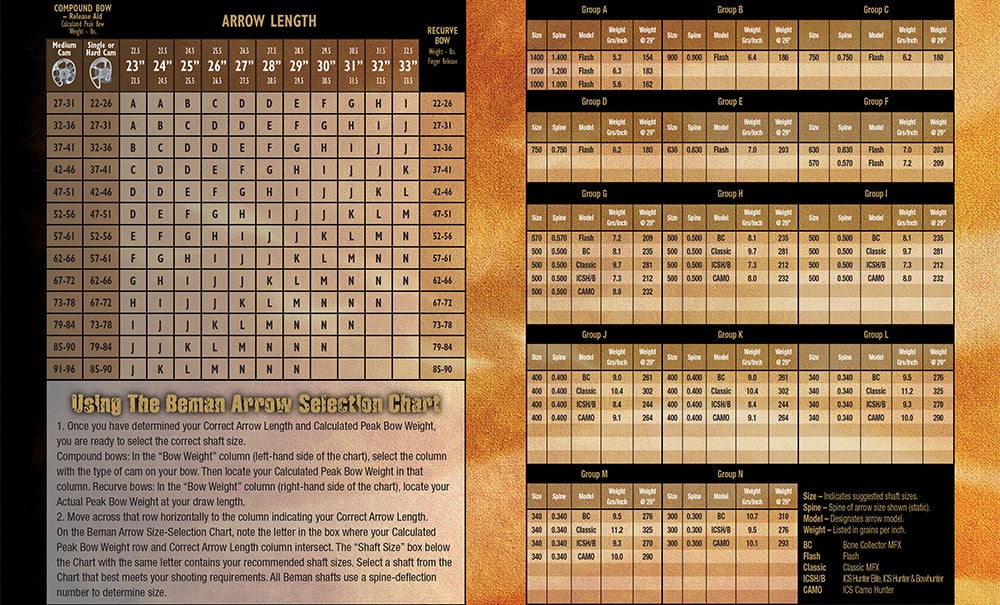Last Updated on
By Rob Boyle
The last two articles (How To Select A Compound Bow – Basics and How To Select A Compound Bow – Advanced Terms) focused on the most important part of your archery gear: your compound bow. The second most important piece of gear you’ll own is your arrows. What is peanut butter without jelly? What is Fred without Ginger? What is a bow without an arrow? The answer is…not much! Each one is completely dependent on the other to give the other purpose (Ok, maybe not Fred and Ginger or PB&J, but you get my drift). This beautiful symbiotic relationship is rarely seen in the world. And that’s exactly why, in this article, we’re going to talk about why your arrow selection is so important.
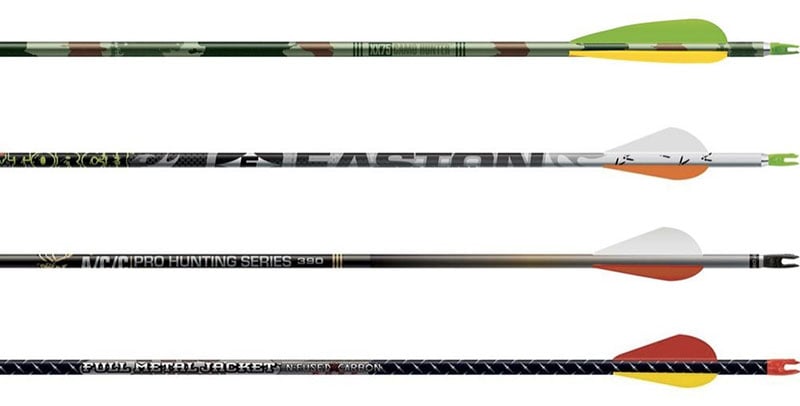
1. Know your arrow
The parts of an arrow are not all that complex. The “business end” of an arrow is called the tip, and when you are practicing in the backyard or at the range, you’ll be using field tips. When hunting game, you’ll be using broadheads (broadhead selection will be another article all its own in the future)!
The insert is a small, metal portion that slides into the front end of the arrow. If there is no insert, you won’t be able to screw in your field tips or broadheads. Inserts are permanently glued into the arrow and shouldn’t ever come out.
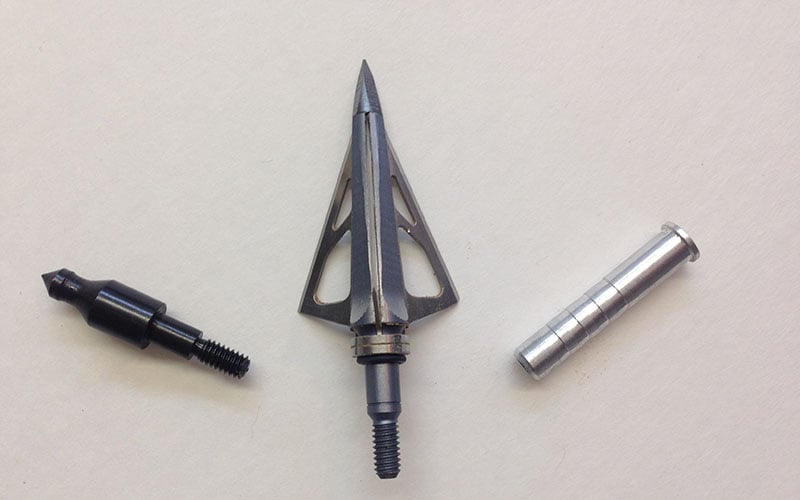
The main, elongated portion of the arrow is called the shaft. Arrows these days are typically made of carbon fiber. Older models of arrows were made of wood or aluminum. These materials have since given way to carbon, which is stronger, more durable and lighter than either of its predecessors. The diameter of the arrow (that is, how thick the arrow is) varies. The latest and greatest arrows are called “microdiameter arrows,” where the diameter is 4, 5, or 6 millimeters. That’s very small! The reason for these microdiameter arrows is that the smaller diameter is believed to cause less friction when going through a game animal (therefore lending to deeper arrow penetration), and it also gives the arrow more stability and less wind drift during flight.
The vanes (also known as the fletching) are the semi-triangular configurations of 3 or 4 plastic or feather pieces that give the arrow rotational stability during flight. Without the vanes, there’s no way to know where your arrow would go once it was loosed from the bow. Vanes typically come in the 2 inch or the 4 inch variety, and they are available in a multitude of color combinations. Vanes can be affixed to the shaft by yourself (if you feel comfortable doing so) or can come on the arrow pre-fletched from the factory. I would recommend picking up some arrows that are already built for you for ease of use as you get started. You’ll notice that one of the three is a different color. This odd colored vane is called the cock vane or the cock fletching, and a three-vaned arrow should always point up when the arrow is nocked.
The nock is located on the rear portion of the arrow and comes into contact with the bow string. Nocks come in various colors and sizes. Also available are lighted nocks, which light up when you shoot the arrow.
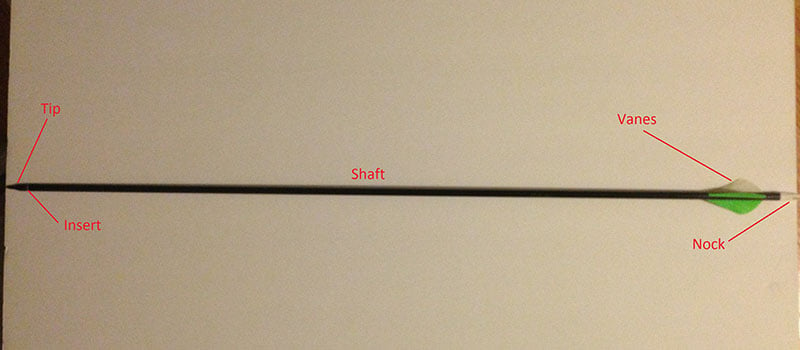
Lighted nocks help you locate the arrow, but they can also provide you with a reference point if you’ve struck the animal and the arrow stays in the animal. And trust me, this is extremely useful at dawn/dusk or in the dark. Deer tend to come in right at dawn/dusk when it is hard to see. A lighted nock will show you whether you hit the animal or not. Additionally, make sure to check that you are buying the right sized lighted nock for your diameter arrow. Also check the local hunting regulations in your state, as lighted nocks are not legal in all hunting situations.
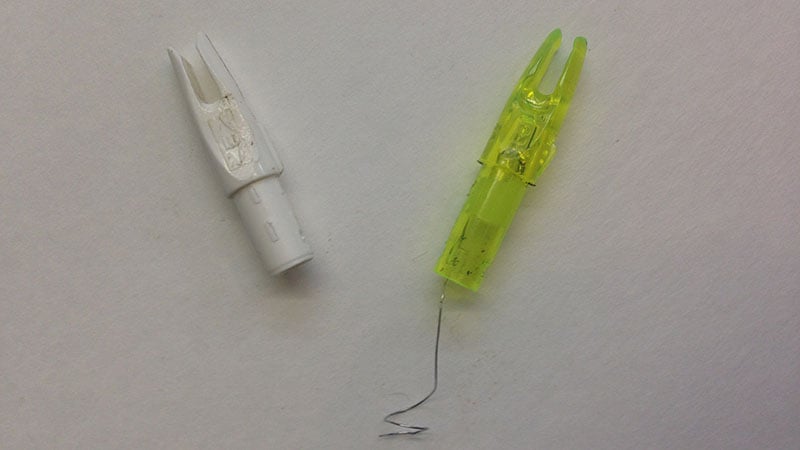
2. Arrow Length
Arrow length is a very important factor in the set up of your bow. Ideally, your arrow, measured from the tip of the arrow (without a field tip or a broadhead) to the throat of the nock, should be ~ ½ to 1 inch longer than your measured draw length. What happens if your arrow is cut too long? Well, a longer arrow adds more mass to your setup, and more mass means that the arrow velocity will be slower with regard to the draw length and draw poundage. So, the longer the arrow, the slower it will go (due to more mass). What happens if your arrow is cut too short? This is a recipe for disaster! If the arrow is cut too short, it’s very possible that upon release of the arrow, it could catch on the arrow rest or the arrow shelf and go through your bow hand. That’s right…you could actually shoot yourself through your bow hand (the hand that holds the bow). This has happened before, not to me, thankfully, but it has happened. I emphatically recommend that you don’t cut your arrows shorter than your draw length. If your draw length is 28 inches, make sure your arrows are AT LEAST 28.5 inches…maybe even go for 29 inches to err on the side of caution.
3. Spine
The spine of an arrow, in short, is a description of how flexible the arrow is. The lower the spine, the more flexible the arrow is. The higher the spine, the stiffer the arrow is. So what spine of arrow should you use? This is can be a difficult question to answer, as the spine of the arrow you choose should be based on the arrow length, tip weight and draw poundage of your bow setup, which, as we already know, can be quite variable. Fortunately for us, various arrow manufacturers make tables that allow you to determine which arrow spine you need for your bow set up. The spine of your arrow is important because if the spine is off for your bow set up, the accuracy of your shot will be severely affected. To add to the complexity of spine, not every arrow manufacturer uses the same spine rating system, which can be somewhat confusing. For example, Bemon uses an arrow selection chart, which I have provided here.
4. Weight
Usually when we think of weight, we automatically think of pounds, ounces, or grams. Arrows, however, are measured in grains. What the heck is a grain? A grain measurement is actually based on real grains of wheat or barley. Scientifically, a grain weighs approximately 65 milligrams, or about the same as one grain of barley or wheat. If the arrow you select is too heavy, you will lose speed and accuracy. If the arrow you choose is too light, you will lose accuracy and possibly cause damage to your bow. If the weight of the arrow is too light, the amount of energy absorbed by a too light arrow will not be fully dissipated. So where does the energy go? Right back into the bow, and this can cause the bowstrings to derail, the limbs to crack or split, or the bow to generally blow up in your hands.
5. Straightness
The straightness of an arrow is measured in thousandths of an inch. For instance, one manufacturer might tote that their arrows are all straight with regard to each other within .001 of an inch. That’s an exceedingly small number. Other arrows, that might be less expensive, might claim their arrows are straight with regard to each other within .003 or .006 of an inch. That’s still a reallllly small number! So, if you’re a competitive target archer who needs to squeeze as much accuracy out of their rig as possible, then you might go with the tighter tolerance of .001 of an inch. If you’re a bowhunter shooting at 20 yards at a large deer or hog, in my opinion, the straightness of the arrow doesn’t necessarily mean too much in the grand scheme of things.
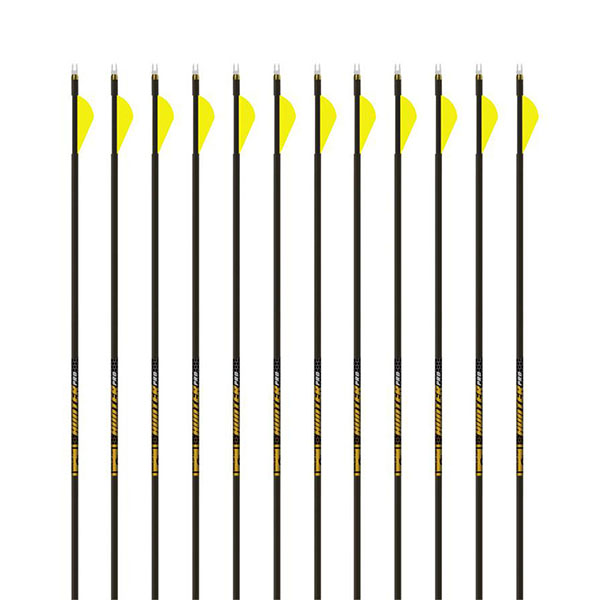
6. Which arrow/manufacturer is right for me?
This is the ultimate question. Which arrow manufacturer do I go with? Why is one arrow manufacturer better than the other? This really comes down to personal preference. Shoot a bunch of different arrows and see which ones group best for you. Pick ones with the correct weight and spine, but ask around and ask other hunters which ones they like to use and why. If you’re hunting big game, use a heavier arrow, and go with a manufacturer that makes arrows especially designed for deep penetration and heavy hitting. No matter what you do, remember, when choosing your perfect arrow, take your time to make the right decision and make sure you have FUN! Happy Shooting!!
